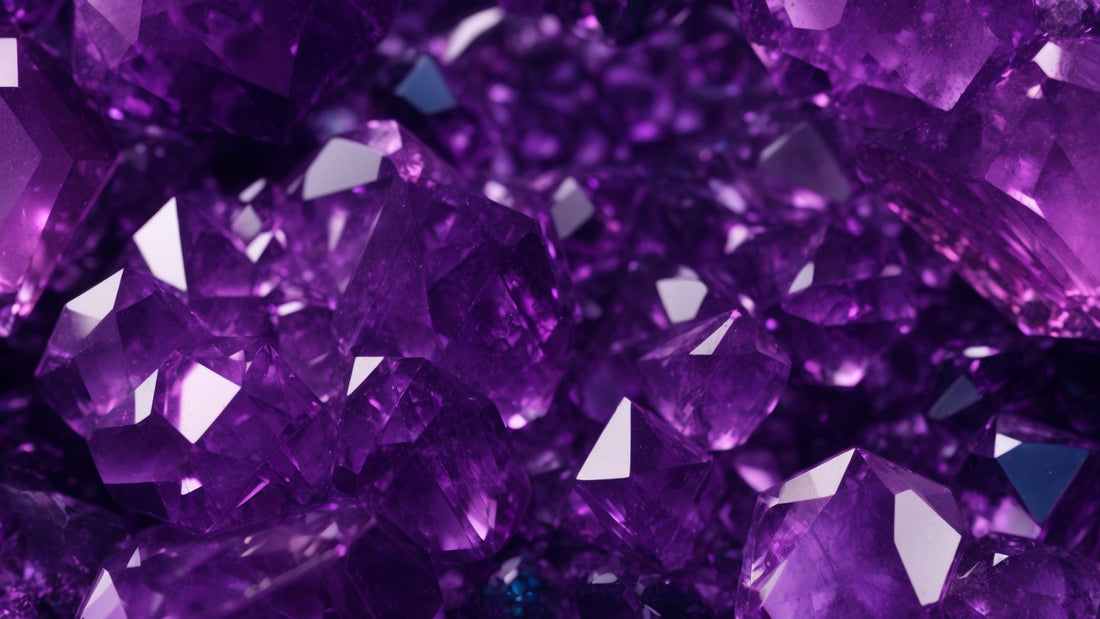
Amethyst: The Purple Gemstone of Tranquility and Power
Share
Amethyst: A Journey into the World of Purple
Amethyst, with its captivating purple hues, has captivated humanity for millennia. More than just a beautiful gemstone, amethyst holds a rich history steeped in legend, spirituality, and scientific wonder. This article delves deep into the world of amethyst, exploring its mineral properties, metaphysical meanings, mining locations, and the enduring allure that makes it one of the most beloved gemstones.
The Science of Amethyst
Amethyst belongs to the quartz family, a group of crystalline minerals known for their beauty and durability. Its distinctive purple color arises from trace amounts of iron and manganese within its structure. The intensity of the purple can vary, ranging from pale lavender to deep violet, with some specimens even displaying a reddish hue.
Key Mineral Properties:
- Chemical Formula: SiO2 (Silicon Dioxide)
- Hardness: 7 on the Mohs scale
- Crystal System: Trigonal
- Luster: Vitreous (glassy)
- Cleavage: None
- Fracture: Conchoidal (shell-like)
Amethyst: More Than Just a Pretty Stone
Throughout history, amethyst has been revered for its purported metaphysical properties. Ancient cultures believed it possessed the power to ward off evil spirits, promote peace, and enhance clarity of thought. The name "amethyst" itself originates from the Greek word "amethystos," meaning "not intoxicated." It was believed to protect against the intoxicating effects of alcohol.
Metaphysical Properties Attributed to Amethyst:
- Peace and Tranquility: Amethyst is associated with calming energy, helping to alleviate stress and promote a sense of serenity.
- Spiritual Awareness: It is believed to enhance spiritual awareness, intuition, and connection to higher realms.
- Protection: Amethyst is thought to shield against negative energies, psychic attacks, and harmful influences.
- Clarity and Focus: Many believe it enhances mental clarity, focus, and memory.
- Love and Harmony: Amethyst is associated with unconditional love and harmony, fostering understanding and compassion.
Where is Amethyst Found?
Amethyst is a relatively common gemstone, found in various locations around the world. However, certain regions are renowned for producing high-quality amethyst crystals:
Major Amethyst Mining Locations:
- Brazil: A leading producer of amethyst, particularly in the state of Rio Grande do Sul.
- Uruguay: Known for its deep purple amethysts, often with striking crystal formations.
- Russia: The Ural Mountains are a significant source of amethyst, producing some of the world's finest specimens.
- United States: Amethyst is found in several US states, including North Carolina, Arizona, and Maine.
- Africa: Countries like Madagascar, Zambia, and Namibia also produce amethyst.
Amethyst in Jewelry and Beyond
The beauty and versatility of amethyst make it a popular choice for jewelry. From elegant earrings and pendants to stunning rings and bracelets, amethyst can be incorporated into a wide range of styles. Beyond jewelry, amethyst is used in decorative objects, spiritual tools, and even healing practices.
Tips for Caring for Amethyst:
- Clean gently: Wash amethyst jewelry in warm soapy water and dry thoroughly. Avoid harsh chemicals or abrasive cleaning methods.
- Store carefully: Store amethyst separately from other gemstones to prevent scratches. Avoid exposing it to extreme temperatures or direct sunlight.
Amethyst: A Timeless Gem
Amethyst continues to captivate and inspire, weaving its way through history, spirituality, and modern design. Whether cherished for its beauty, its metaphysical properties, or its unique place in the world of geology, amethyst remains a treasured gem, offering a touch of serenity, power, and elegance.
